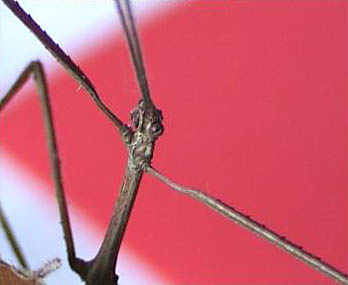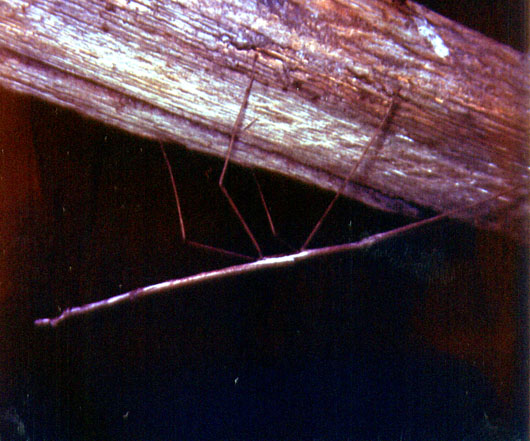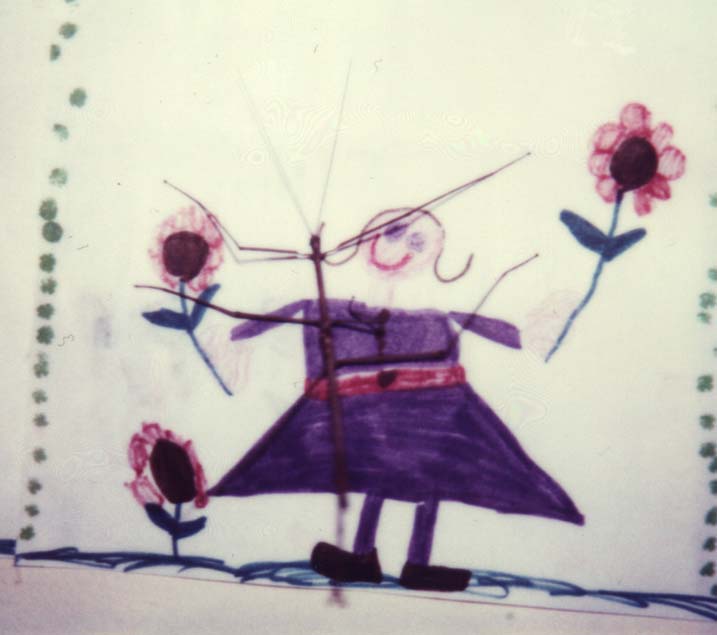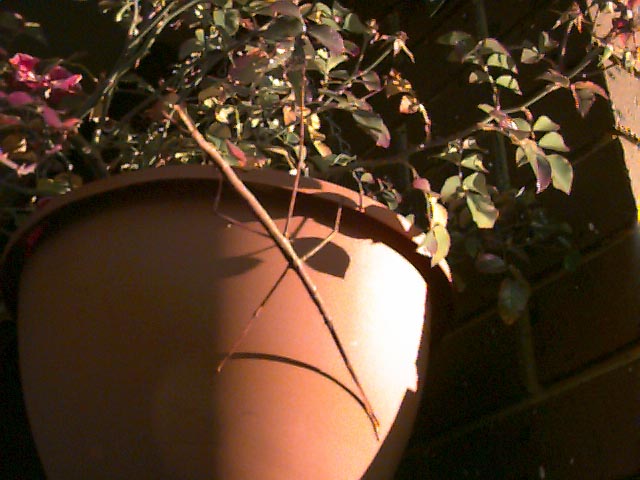
Since stick insects are partial to rose bushes, blackberries and other plants, and since they do not seem to be great at flying (some have no wings at all) it is a mystery how one might get to be up a tall building.

16 May 1998
Around 10 PM this Saturday night, I heard some banging and dogs howling. I went outside, and determined that it was distant fireworks - which I could not see. At the entrance from the driveway to the back-yard is a very old wooden framework. I could push it over with one hand, but am letting it take its time to fall down when the mood takes it.
Hanging upside down from this framework's gateway, was a Stick Insect! It is years since I have seen one - and I don't recall seeing one in my 17 years at Miller St. The last one I saw was perhaps bigger than this - my mother found it. That was probably five years ago at least.
I had been thinking of them recently - they are such engaging creatures, and I hadn't seen one for a long time.
I took a photo of it in-situ with my Polaroid SX-70. Then I brought it inside and took a few more. Two didn't show it very clearly, and the one which shows it best - the second one below - was nearly a failure since I was holding the camera with one hand, and this blocked the film coming out. So the film was bent and did not develop properly.

Its body is basically a thin stick, at the most about 1/8" wide - where it keeps its wings folded.
In the photo above, the head is to the right and its feelers are together in front of the head.
The body is 4 1/4" (110 mm) long. The six legs are all about the same dimensions. The rear leg was 1 1/2" (40 mm) to the knee and 2 1/4 (60 mm) to the foot. It has two very active feelers - I measured them as being about 2 1/2" long (65 mm). So the entire insect is around 6 1/2 inches long. Generally its feelers were stuck in different directions and waving in the air as shown below. However I did see it outside at one stage with the feelers together (as shown in the top photo) extending the line of the body as if it was one long stick. The tail end of the body looks like a broken off stick. The head is very small. I didn't get a close look at it.

This is the best photo, and probably shows it real-size on many computer screens.
I set it climbing up a painting on the wall - Olivia's painting of Alison. This was tricky for the Stick Insect, since it had difficulty gripping the surface of the painting. It was good for me since it gave me a few more seconds to get it in focus - not that I did that very well. Once it found the top of the painting, and the painted plaster wall, it was off at a rapid rate!
This is out of focus, but shows it approximately full size on most people's computer screen.

Alison seems quite happy with her new friend!
When I put it on my hand, it marched quickly uphill, onto my shoulder and started trying to clamber onto the top of my head. At one stage it lost interest in this and flew for a few seconds. It can't fly very well - I guess this is a means of escape rather than transport. But walk? Hell yes! Clamber? Yes-sirr-eee!!
After the 8 minutes or so in the photo studio, I put it back where I found it - and a few minutes later, it was not there any more.
These wonderful creatures can walk or climb a foot in a few seconds, and I doubt that anything would stand in their way.
I wonder what the frogs think?
- Robin 11.30 PM Saturday 16 May 1998
Post-script: Alison tells me that she would not be at all comfortable with an insect "crawling" this close to her face. However this magnificent creature doesn't crawl! It takes strides! It clambers! It marches onwards irrespective of the terrain! (Climb every mountain, Ford every stream . . . ) It is easy to pick up - just place your thumb and forefinger in a ring around its body and between some of its legs. It seems rather delicate - and you can feel and hear it gently (but with as much vigour as it can manage) trying to extricate itself with all six legs at once.
A quick web search brought me to a Stick Insect Web page!! Isn't the Net a wonderful thing?? Mark Watson has a detailed site devoted to these creatures - and a mailing list too. He has a special stick-insect room and breeds a number of species. Marks page has many up-to-date links.
http://homepage.ntlworld.com/mark.watson/
http://www.woodbat.co.uk/stick.htm
http://www.amonline.net.au/factsheets/phasmids.htm
http://www.earthlife.net/insects/psg.html also perhaps at, you guessed it . . . http://www.stickinsect.comAs a shorthand, phasmid species are often referred to with a simple number such as "PSG 111", based on the Group's study of the species. Human members of the Study Group seem especially proud of their membership number . . . I guess the lower the better.
The German Exotica site has some pictures of the extraordinarily different male and female of one species, and how they mate. The male is bright red and looks half the size of the female.
http://www.exotics.net/oreo/
The University of Arizona College of Agriculture
has a web site structured according to the "tree of life" - which is
(as
best as can be understood) the branching diversification of life-forms
starting from the very earliest known cells and viruses. Of
course
there are uncertainties in this field. The tree starts with
viruses,
bacteria and eukaryotes (protists, plants, fungi, animals, etc.).
http://phylogeny.arizona.edu/tree/life.htmlStick insects are classified under order Phasmatodea. Their URL in this tree is:
http://tolweb.org/tree/eukaryotes/animals/arthropoda/hexapoda/phasmida/phasmida.htmlPhasma means (in latin, I presume) "apparition or specter". Insects of this form first appeared in the fossil record during the triassic period (the one before the jurassic) 245 - 208 million years ago - around the time the first dinosaurs appeared.
The North Carolina State University College of Agriculture and Life Sciences has a comprehensive listing of hexapods - most of which are insects. Their Phasmatodea page which used to be at:
http://www.cals.ncsu.edu/course/ent425/compendium/stick.htmlsays that there are over 2,500 species of "Walkingsticks / Stick Insects / Leaf Insects / Phasmids" - 32 of which are found in North America. The following points are quoted from the above site:
- Robin 1.50 PM Saturday 17 May 1998 (Updated since then with new links added and dead ones pruned.)
After corresponding with the Museum of Victoria, and a number of phasmidophiles in Australia, England and the UK, I have decided that this is probably a male, because quite a few species have winged males, and larger and more numerous females.
Micheal Leverett <leverett@apollo.ruralnet.net.au>, who is raising some stick insects, has photos at http://exotics.net/sticklist/micks_sticks.htm and is currently working on his own site, wasn't able to identify my visitor.
The resident entymologist that the Museum of Victoria http://www.mov.vic.gov.au/ fired up her computer and took a look at my site. She wasn't able to go into detail (its a miracle with Vic govt, funding cuts that anyone is funded by the public to identify insects) but she reckons it is a ctenomorpha of some kind. I will go in there one day and take a look at their collection and reference works. She said they liked long grass, and were virtually impossible to see in the grass. She also mentioned tropidoderus - which apparently has nave blue wings. I only caught a glimpse of my guest flying, and I didn't notice anything special about the wings - but I couldn't rule out them being blue.
Graeme Wagener <gwag@mail.surf.net.au> told me he thinks my visitor is a Sipyloidea filiformis - which frequent long grasses and have taken to attacking the rose-bushes of a friend to the south of Melbourne (they like the leaves). He says he has seen these in Gippsland (eastern Victoria) years ago.
I am no taxonomist, so I am presenting the above evidence pretty-much verbatim for the interest of those with deeper knowledge.
The Phasmid Study Group used to have a list of species they are familiar with, at: http://www.ex.ac.uk/~gjlramel/phas-species.html . I have created a reformatted version of their December 1997 list, which prints out nicely on A4 paper in landscape mode (File: Page Setup in Netscape) and which may be easier to read on screen. That list is here: phas-species-small.html Be sure to check at the Phasmid Study Group site linked to above for their latest version.
The species on the list which seem to be of most relevance to my visitor are
PSG SCIENTIFIC NAME SUB FAMILY ORIGIN NOTES PREFERRED SPECIES
No. (of culture stock) 1 2 3 4 FOODPLANTS REPORT
15 Ctenomorphodes briareus (Gray) Phasmatinae Australia. S C L W B. O. E. 7
65 Sipyloidea sp. Necrosciinae Sabah. P* L S W B. -
74 Ctenomorphodes sp. Phasmatinae Australia. S L L W B. O. E. -
103 Sipyloidea sp. "THAILAND 8" Necrosciinae Thailand. S C M W B. E. Ra. Ro. (41:17)
143 Sipyloidea sp.? Necrosciinae Bali. S C S W B. Py. -
163 Sipyloidea sp. Necrosciinae Australia. S C S W B.E.H.Py.Ra.Ro. (63:3)
193 Tropidoderus childrenii Gray Tropidoderinae Australia. S C M W E. -
M = 10 - 15 cmI would appreciate any further information on Stick Insects, especially in Australia. I am not going to capture or raise these creatures, but I do appreciate them. Every time I go under that piece of wood to my back-yard, my eyes are peeled for another auspicous visitor - but the chance of seeing another one there or anywhere else seems remote.
L = over 15 cm
- Robin 26 June 1998
28 July 1998
Here is a picture of a stick insect, of the same species as my distinguished guest, in Bayswater, a south-eastern suburb of Melbourne.
Thanks to Gail Fernando <Gailf@bass-soft.com.au> for this photo and report!

Dear Robin
I have become an enthusiast ever since I found a Stick Insect on our
Rose plant about the middle of April. I got your address of your web page
after spending time reading up about this interesting little creature on
the Internet. Our little friend 'Sticky' seems to be quite taken with our
plant - it hasn't moved off it at all. With the delightful weather we had
2 weekends ago, I was able to take some photographs. Please find
enclosed a picture of 'Sticky'. We live in Bayswater, and even though the
plant (which is in a hanging basket) is exposed to cold winter weather,
Sticky doesn't seem to mind it one little bit. My husband & I just love
watching it nibble on the leaves and David (my husband) even swears that
Sticky sways when he whistles at it. We have not attempted to pick it
up, in case we frighten it off.Best regards
Gail Fernando
The above picture shows the stick insect with its head down to the
bottom right. The head, I think, is about one third of the way from the
front legs to the end of the feelers, which in this photo are closed
together.
Melbourne in the last 24 hours has been buffeted by high winds, and Gail wrote:
With the high winds we had last night, I kept worrying about 'Sticky'. TheI am most impressed by this stick insect staying put for over three months! I am wishing I had found a nice place for my visitor. I have encouraged Gail and David to keep an eye out for any eggs that the stick insect may be dropping on the ground.
first thing I did after waking up today, was to look out of the window and
ensure 'Sticky' was still on the plant. And it was! I wonder if this is some
kind of record for a insect of this type to stay in the one place for so long -
maybe it is!
I will happily link to other stick insect sites, or include images here of such distinguished visitors!
If you like Stick Insects, perhaps you might be interested in my 21
metre Sliiiiiiiiiiiiiiiiiinky?